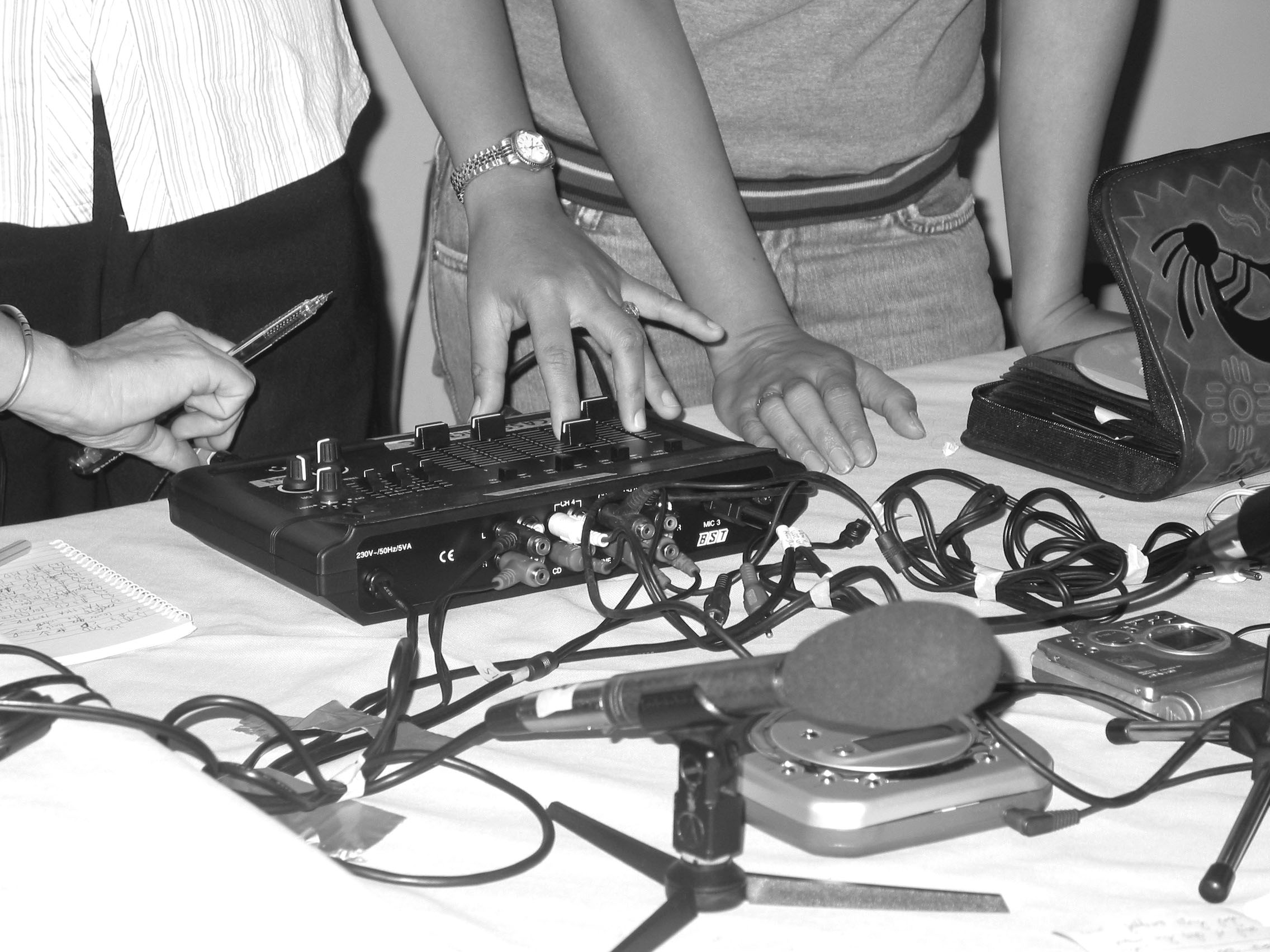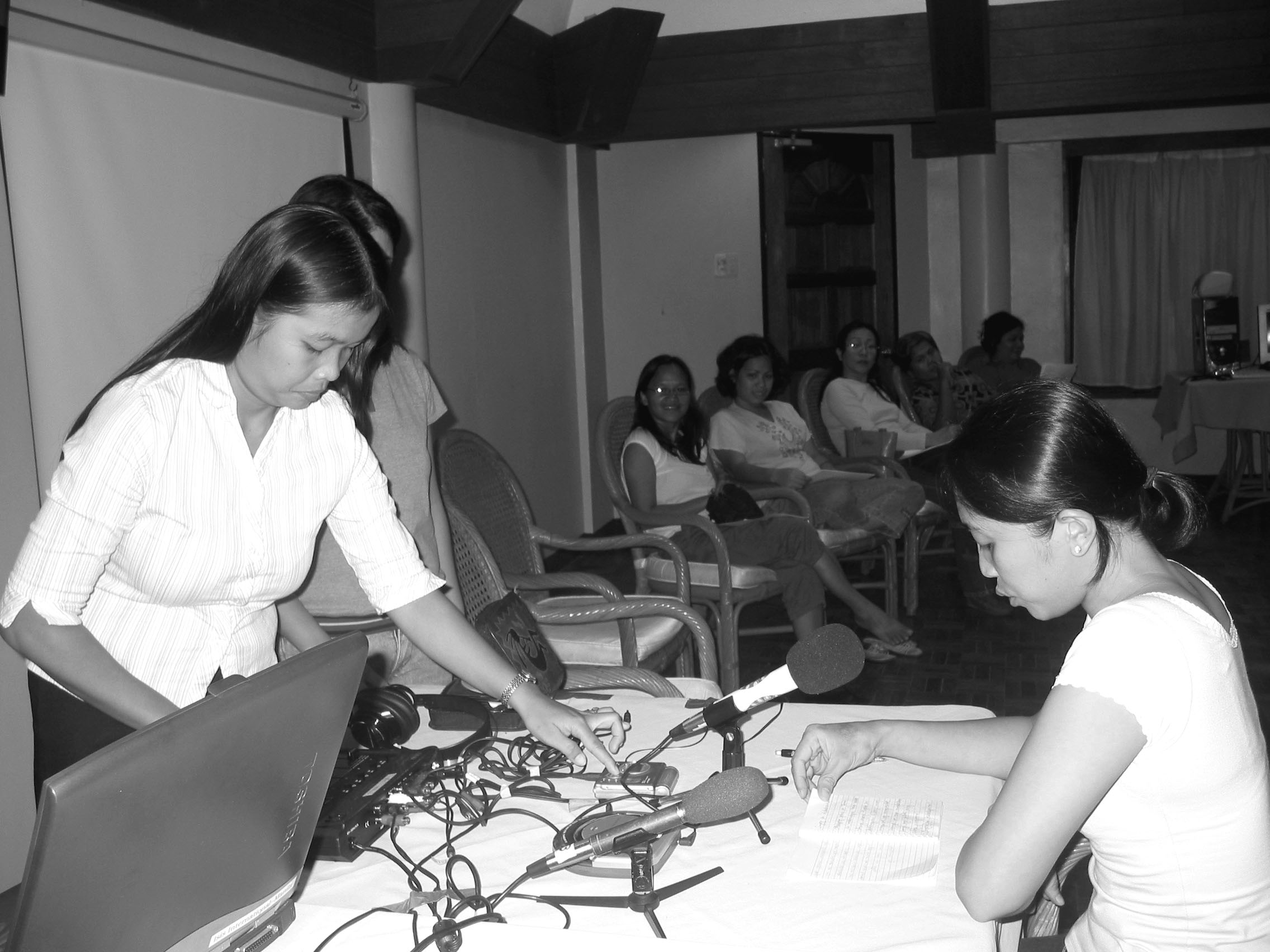
Women Journalists Train for Peacebuilding
This year, Isis International-Manila and Women Writers of Mindanao, Inc. (MinWow) teamed up to develop and conduct “Women Making Airwaves for Peace,” a five-day training program in three different cities in Mindanao, Philippines, namely, Cagayan de Oro, Zamboanga, and Cotabato.
The project aims to raise awareness and build on the capacities of community-based women journalists on how to effectively report on conflict and post-conflict areas using the lens of gender-based conflict transformation (a perspective that accommodates civilian conflict resolution and management methods that include women and children’s needs)
 The first leg of the training, held last October 25-29, 2006 in Cagayan de Oro City, was attended by teachers, radio reporters, students, NGO workers, and activists. The message of the program was clear: women are not only at the receiving end of public policy in the South, rather, women have an active role in shaping policy. While MinWow is in charge of content development on peace, Isis-Manila shares its expertise in community radio production. “When we decided to work together, we talked of synergy (and) convergence,” said Lina Sagaral Reyes, project coordinator for MinWoW.
The first leg of the training, held last October 25-29, 2006 in Cagayan de Oro City, was attended by teachers, radio reporters, students, NGO workers, and activists. The message of the program was clear: women are not only at the receiving end of public policy in the South, rather, women have an active role in shaping policy. While MinWow is in charge of content development on peace, Isis-Manila shares its expertise in community radio production. “When we decided to work together, we talked of synergy (and) convergence,” said Lina Sagaral Reyes, project coordinator for MinWoW.
What “Women Making Airwaves for Peace” is all about
Women Making Airwaves for Peace is a collaborative project of Mindanao Women Writers, Inc (Min-Wow) — a community based alternative journalist organisation, and Isis-International Manila—an international feminist information and communication NGO. The project is envisaged to raise awareness and build on the capacities of community-based women journalists on how to effectively report on conflict and post-conflict areas using the lens of gender-based conflict transformation. The project looks at strengthening women’s participation in peace processes (and civil society in general), towards new definitions and notions of peace in social transformation.
In particular, this project seeks to:
i) evolve the reportage of peace efforts as news-worthy and promote responsible journalism that gives equal “billing” and attention to women;
ii) through skills training and the promotion of responsible journalism amongst community women media practitioners, usher in a situation where women’s participation in peace processes and civil society is empowered;
iii) train community-based journalists adequate skills on radio production that will facilitate the development of radio clips in the promotion of cultural diversity and a culture of peace; iv) introduce community radio as a medium with great potential in support of women’s empowerment especially in areas of conflict; and
v) explore women’s active participation and maximised utilisation of existing community radio stations and/or the creation of new women community radio stations as cooperative enterprises.
The need for training on peace journalism
Fierce and/or remnants of conflict, discord and violence between the resistance and the state (Philippine military) and amongst warring armed factions and groups (i.e., private/clan armies etc.) remain to be one of the more prominent challenges to the sustainable, humane, engendered and environment-friendly development of the second largest region of the Philippines, Mindanao. Internal strife in Mindanao, in particular, Northwestern and Central Mindanao, is very real; its peoples, subject to life-threatening situations, particularly women and children, in a never ending spiral of violence that has consumed what is probably one of the richest islands of the country.
Northwestern and Central Mindanao is composed of the provinces of Zamboanga del Norte, Zamboanga del Sur, Basilan, Sulu, Tawi-Tawi, Misamis Oriental, Misamis Occidental, Bukidnon, Lanao del Norte, Lanao del Sur, Maguindanao, Sultan Kudarat, North Cotabato, and parts of South Cotabato. Altogether, the population is estimated to reach more 10 million count (a seventh of the total population of the Philippines).
 Militarised societies politicise journalism, the conduct of reportage, and the selection of coverage. Hence, the role of media is critical, but one that is exponentially sensitive and calls for responsibility. The coverage of Northwestern and Central Mindanao by local and community-based media people is most often than not limited to war-reportage—the numbers of fatalities, clashes, encounters deemed as more provocative for the general readership. Disconcerting are the methods by which mainstream journalists cover conflict zones. Seldom are peace talks and processes perceived as news. Further, traditional sites where journalism trainings take place are not adept at capturing and developing the skills necessary in approaching and framing conflict situations.
Militarised societies politicise journalism, the conduct of reportage, and the selection of coverage. Hence, the role of media is critical, but one that is exponentially sensitive and calls for responsibility. The coverage of Northwestern and Central Mindanao by local and community-based media people is most often than not limited to war-reportage—the numbers of fatalities, clashes, encounters deemed as more provocative for the general readership. Disconcerting are the methods by which mainstream journalists cover conflict zones. Seldom are peace talks and processes perceived as news. Further, traditional sites where journalism trainings take place are not adept at capturing and developing the skills necessary in approaching and framing conflict situations.
In the region of Northwestern and Central Mindanao, as in any militarised society, women are reduced to victims, their voices silenced during times of conflict, as well, in efforts of peacebuilding and reconstruction. Women are passive observers, branded as lacking “brawn” during times of war/conflict, and “brains,” during reconciliation, reconstruction and peace efforts. Existing women leaders, organisations and networks are not regarded as potential or active participants and contributors to conflict management; their experiences and wisdom meaningless to a predominantly masculine concept that for decades, have steered the living conditions of women and children to what defines the community at present.
While there have been attempts by various organisations to deepen the critique of mainstream writing (and news), there remains a strong culture of putting women voices, experiences and analyses in the back burner. This project aims at contributing toward the articulation of community women media perspectives on development, citizenship and democracy and address the problematique that there is no real development without women’s empowerment and participation.
This series of training seeks to enhance the crucial role media plays in conflict resolution and peacebuilding in Mindanao. Furthermore, it covers technical skills enhancement as well as self-care and safety strategies for women community journalists.
This project is in line with the overall work of Isis-Manila’s Community and Independent Media (CIM) Programme which puts emphasis on the transformative potential of community radio for women’s empowerment and peace building.
Community radio for peace
In what is now referred to as an “information society” there is a boom of new information communication technologies (ICTs). But radio technology, though one of the oldest, remains one of the most useful, and far reaching communication technologies around. Radio continues to play a crucial role in bridging the so-called digital divide. Radio is not a new ICT but it remains a strategic ICT that can connect remote communities to other communities, cities, and even other countries. As well, radio technology is a domain traditionally and largely dominated by men, a condition “Women Making Airwaves for Peace” intends to challenge.
Infrastructure requirement for radio is affordable, easy to maintain and direct skills transfer and operations easy to facilitate. The fact that there are already several community radio stations existing in the Asia-Pacific region indicates that community radio is appropriate, well-received and can be empowering to marginalised groups. Though the presence of radio in communities allows higher levels of community participation, the impediments to the set-up of community radio arise from existing legal requirements that limit its proliferation. Existing requirements prove unfavourable for low-powered, non-profit radio stations. Such structural policy blocks will need to be addressed at the local, provincial and national levels.
The community radio technology being introduced can be easily replicated and multiplied in the most remote areas. Radio technical skills are easy to transfer and trainees in the training sessions can easily evolve into trainers themselves.
Min-WoW and Isis-Manila remain committed to its community radio advocacy and believe that the Philippines may be able to join the ranks of Thailand and Indonesia that have hundreds of thriving community radio stations. To date, Thailand has over 300 community radio stations all over the country, and Indonesia, over 600. The presence of community radio stations in remote communities do not only inform members of these communities, but are also capable of providing actual and up to date news on the conditions of the remote communities. This was most apparent during the Asian tsunami of December 2004, when community radio stations in the South of Thailand provided up to date news to mainstream media and other independent media within the country and within the region. Similarly, in Aceh, community radio continues to play a significant role in coordinating relief and reconstruction efforts.
Access to information is empowering and in an archipelagic country like the Philippines, initiatives and tools that are able to facilitate the exchange of information (and access to it) are crucial in building peaceful lives and peaceful communities, whether community radio be used for relief and reconstruction in times of natural and unnatural disasters, and/or for promoting inter-cultural understanding and respect amidst differences and diversities.





 The
The 
 Isis Resource Center holds one of the largest feminist collections of materials in the Global South. With 40 years of publication experience, Isis holds a vast collection.
Isis Resource Center holds one of the largest feminist collections of materials in the Global South. With 40 years of publication experience, Isis holds a vast collection.